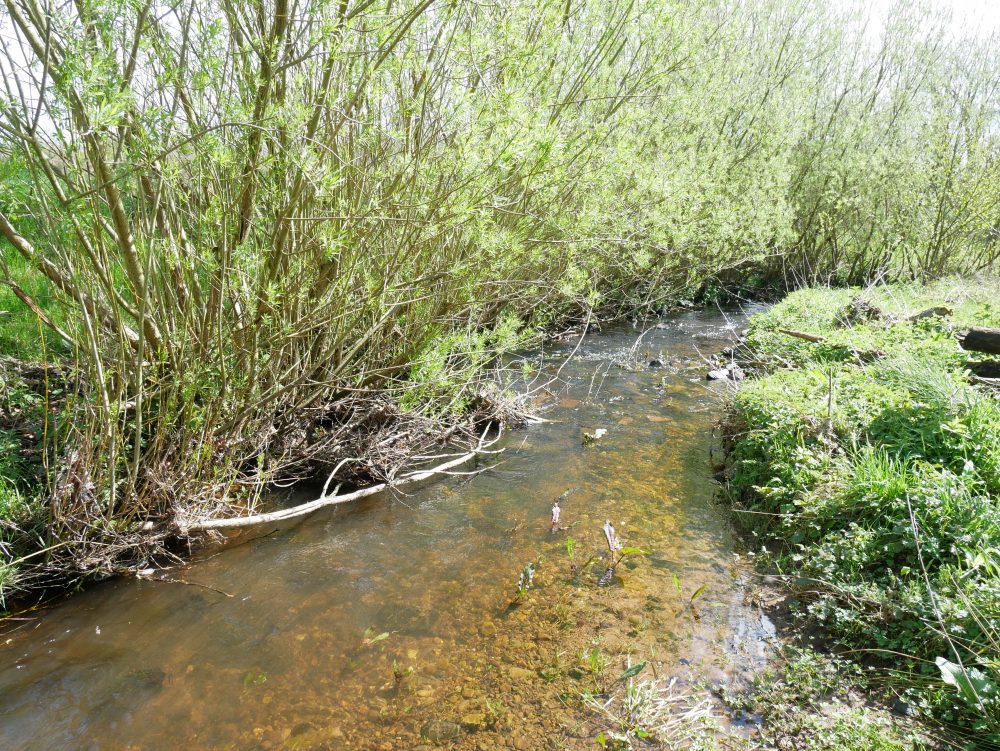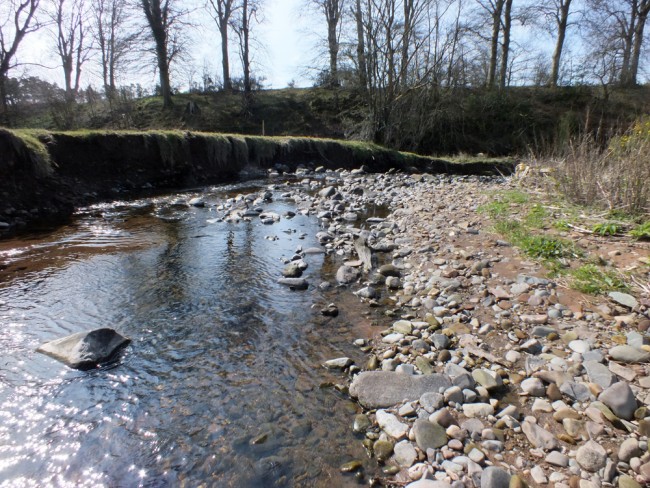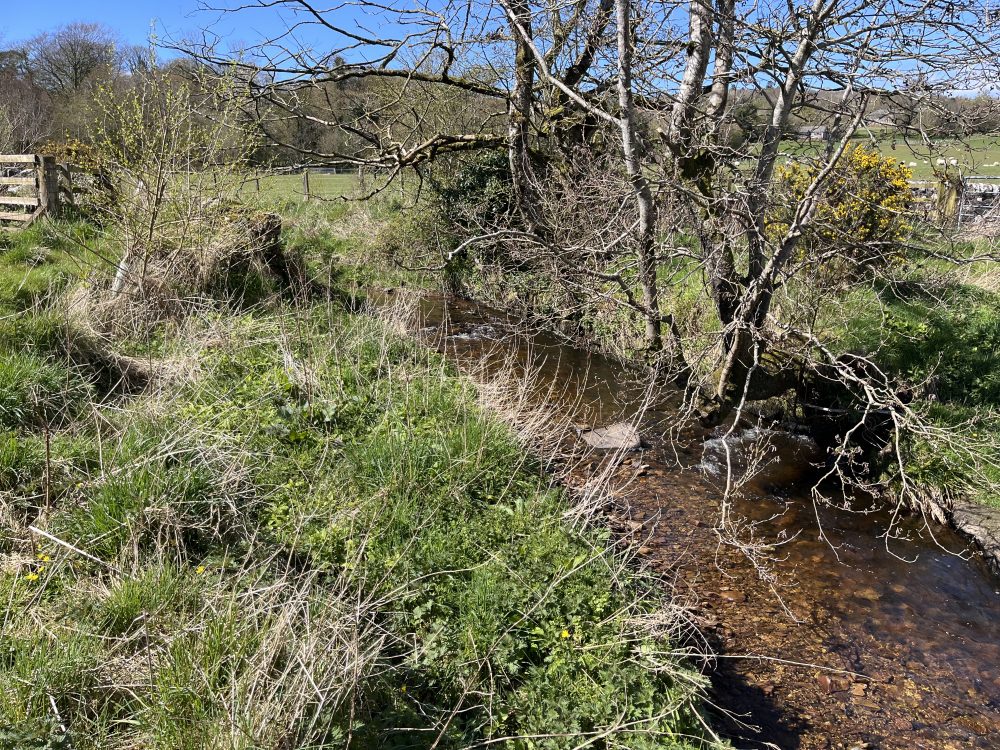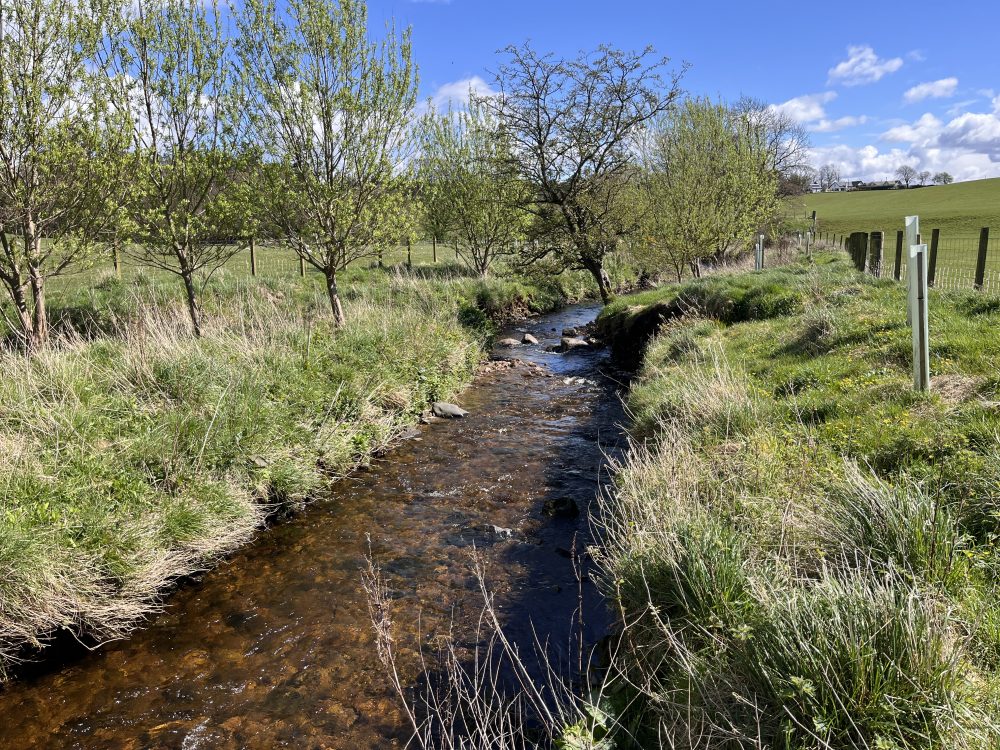With financial support from the River Doon DSFB we commenced improvements on the Culroy Burn back in 2015. Several areas had been identified that suffered from accelerated erosion and severe nutrient inputs that the Trust staff considered solvable. We knew water quality and fish production were impacted. The silt load in this burn lead to the gravel being smothered and the habitat throughout was in less than good condition. Being a juvenile recruitment area rather than fishing beats, its was important to address these issues to overcome some of the challenges that salmon and sea trout face at the current time. This post demonstrates some progress we have made. Things will continue to improve with more time.

A much changed and improved habitat in 2024

Bank reinforced by trees and willow spilling. This was installed in 2016 and has developed into a robust structure that offers cover and shade to juvenile fish and of course birds and mammals too. The burn has narrowed and deepened at the toe of the bank. The opposite bank has vegetated as the burn is more stable within its channel and is no longer wandering uncontrolled across farmland.
The Culroy Burn was traditionally a trout (brown and sea trout) burn but the DSFB had over many years stocked salmon. Neither species were naturally doing well by the time we started improvements despite this being a major tributary of the middle Doon catchment. The aim was to cut erosion and inputs and restore the quality of the habitat and thus production. After 9 years since we started, we were asked by the Board and have to ask ourselves, has this worked? Well the answer is yes and no. Erosion has been cut, water quality has improved, trout numbers have increased tremendously but salmon stocks remain very poor. Our opinion is that yes the work undertaken has achieved great benefits for fish and ecology however, with salmon survival at sea being desperately poor, few salmon are returning to repopulate this burn. Those that do, should have a much better chance of survival to smolt as they have clean water and good habitat once again.
Have a look through the photos below that show the condition of the burn in two key areas where we decided to install green engineering and then fencing to exclude livestock. Combined with this, we have planted trees that are beginning to provide shade and cover that will bring additional benefits as they mature.

The situation that we faced in 2015 before work commenced at Blackbyres. Erosion added fine sediment to the burn and land loss was considerable. The left bank was about 1.2m high and sheer. The fine sediment on the bed and obvious between the exposed cobbles on the right bank were damaging. Compare this to a similar view of this location in the previous photo
We did have setbacks along the way with storm Abigail coming within days of us completing the work and destroying much of the work we had done. Never the less, we persevered and reinstalled the following spring and since then, there has been steady improvement. Some of the riparian trees we planted are doing well but others have been damaged by deer and hares. We will replant more and provide guards to help them become established.

Most trees we planted are doing well but deer and hares have taken their toll. We will plant more to bolster the area but with guards this time
Further upstream at Sauchrie, in early summer 2017 we also tackled severe erosion and nutrient inputs while at the same time removing a redundant weir. The change to this stretch of habitat is impressive and undoubtedly beneficial. Again, we could do more here and will continue to add trees to combat the losses of browsing mammals. But, the in stream habitat has changed dramatically with the burn narrowing and deepening. The cattle that once added nutrients and contributed to erosion have been excluded and water quality is now suitably good. Banks have rebuilt and stabilised as happens when the pressures are removed and we expect through time this stretch will become increasingly populated with fish (something lacking in 2017).

Prior to commencing work in 2017 and problems are obvious

Bare sediments exposed by erosion and in stream silt were a feature in 2017 when this image was taken. This was unnatural caused by a collapsed bridge just upstream. We removed the structure as we set about the work. Compare this to the next image taken in 2024 of the same area (but looking upstream in the opposite direction).

This photo is taken looking upstream in 2024 but shows where the gravel was exposed in the previous image. The burn has narrowed and the gravel in the bed is clean and free of silt. The bank has rebuilt and re vegetated.

Shortly after the obstructions were removed and the fencing installed in 2017. The burn was overwide, full of algae due to nutrient enrichment and had virtually no shade or trees in this area. Compare this to the images we took in April 2024 below.

This image was taken in 2024 after the burn has narrowed and stabilised. Livestock erosion has ceased and the banks vegetation and trees are developing well.

A transformed habitat that will continue to improve over time. The main work to improve this section consisted of livestock fencing and slight re profiling of the worst eroded banks. Apart from that, a few trees have been planted and are developing well. The habitat is far more suited to fish and wildlife than it was previously.
We have undertaken some assessment fo the fish population in this burn since we worked these areas and installed fencing. Trout numbers have increased tremendously and we hope will continue to do so. Salmon on the other hand have been slower to respond but that is more likely to be due to low numbers returning from sea rather than anything else and we know if they do spawn anywhere in the Culroy Burn in future, their survival should be much improved. Of course this was traditionally a trout rather than salmon habitat and that situation may prevail but any improvements done will benefit both species if they do choose to spawn here.
Additional benefits reported by by anglers and owners downstream is that water clarity as spates run off clears much quicker that previously and this is due to the reduction of fine silt and sediment produced in this burn. By making these improvements, we are giving salmon every chance to increase in numbers and their range within the Doon catchment and we are grateful to the Doon DSFB for their proactive support for this type of work. This is exactly what we believe river managers can and should do to help salmon survive at this worrying time when their marine survival is so poor.


Good work a.r.t. habitat improvements are badly needed on most ayrshire burns and tributarys. Sadly most clubs and anglers not interested in doing habitat improvements….